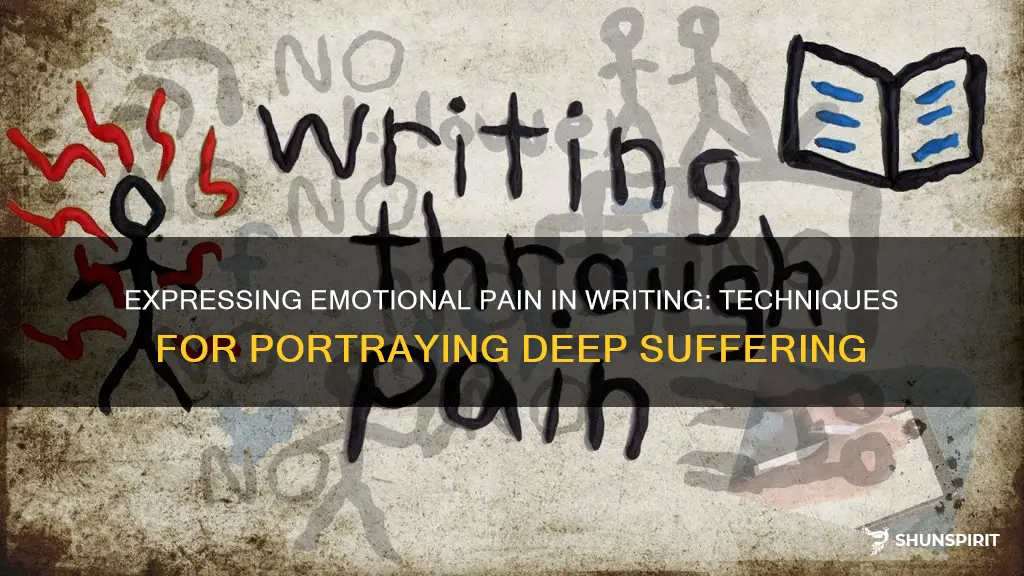
There is an undeniable power in the written word, capable of evoking emotions that resonate deep within our souls. One such emotion, often hidden behind a veil of stoicism and resilience, is emotional pain. Revealing this complex and intensely personal experience can be a daunting task for writers. However, by carefully crafting scenes, dialogue, and descriptions, writers have the ability to vividly illustrate the depths of emotional pain and connect with readers on a profound level. Whether it be through heart-wrenching confessions, gritty depictions of physical discomfort, or the haunting absence of joy, the art of showing emotional pain in writing has the potential to leave an indelible mark on the hearts and minds of its readers.
| Characteristics | Values |
|---|---|
| Usage of descriptive language | Deep and intense |
| Showing physical manifestations | Shaking, trembling, chest tightening |
| Describing negative thoughts | Hopelessness, despair, self-loathing |
| Depicting isolation | Solitude, loneliness, feeling of being disconnected |
| Portraying loss | Grief, heartbreak, emptiness |
| Utilizing metaphors | Darkness, storm, sinking |
| Expressing vulnerability | Tears, raw emotions, fear |
| Incorporating internal dialogue | Self-doubt, self-criticism, questioning one's worth |
| Depicting withdrawing behavior | Avoidance, shutting down, pushing loved ones away |
| Describing emotional exhaustion | Drained, empty, tired |
What You'll Learn

Ways to Depict Emotional Pain in Writing
Emotional pain is a powerful force that can consume us, affecting both our minds and bodies. As writers, it is crucial to convey this pain effectively, allowing readers to truly feel and understand the emotional turmoil our characters experience. One effective way to do this is by utilizing imagery and sensory details to describe physical manifestations of emotional pain.
When a character is in the grip of emotional pain, their body may react in a variety of ways. For example, they may feel a weight on their chest, making it difficult to breathe. To describe this physical sensation, you could use imagery such as "a crushing weight pushing down on their chest, making every breath a struggle." This allows readers to tangibly feel the character's anguish.
Additionally, emotional pain can manifest as tension in the body. To depict this, you might describe the character's muscles as being "taut like a tightly wound spring, ready to snap at any moment." This vividly conveys the physical strain and discomfort they are experiencing.
Incorporating sensory details can also enhance the portrayal of emotional pain. For instance, you could describe the character's hands trembling uncontrollably, their skin becoming clammy with sweat, or their mouth becoming dry as though filled with sand. These sensory details add depth and realism to the portrayal, allowing readers to fully immerse themselves in the character's emotional state.
Metaphor and symbolism are powerful tools for conveying emotional pain indirectly. By comparing the character's emotions to something else, you can evoke a visceral understanding in your readers. For example, you might describe their pain as a "raging storm, tearing through their heart and leaving destruction in its wake." This metaphorical language adds depth and intensity to the description, enabling readers to grasp the true magnitude of the character's anguish.
Symbolism can also be utilized to convey emotional pain. For example, you might use the image of a withered flower to represent the character's sense of despair and loss. By repeating this symbol throughout the story, you create a consistent visual reference that helps readers connect with the character's emotional journey.
Crafting realistic dialogue and internal monologue is another powerful way to capture a character's emotional turmoil. Through their words and thoughts, readers can glimpse the depth of their pain. When writing dialogue, consider using short, fragmented sentences or interrupted speech to reflect the character's inner turmoil. For example, instead of a straightforward statement like "I'm hurting," you might have the character say, "It... hurts... so much," with pauses between each word. This emphasizes their struggle to express the enormity of their pain.
Internal monologue is also a valuable tool for conveying emotional pain. By delving into the character's thoughts and innermost feelings, you can reveal their raw vulnerability. For example, you might have the character repeatedly question themselves, thinking thoughts like "Why am I always so broken?" or "Will this pain ever end?" These introspective moments allow readers to witness the character's emotional journey and connect with their pain on a deep level.
In conclusion, accurately depicting emotional pain in writing requires the use of imagery and sensory details to describe physical manifestations, the utilization of metaphor and symbolism to convey the pain indirectly, and the crafting of realistic dialogue and internal monologue to capture the character's emotional turmoil. By employing these techniques, you can create a rich and impactful portrayal of emotional pain that resonates with readers and enables them to empathize with your characters.
Raising an Emotionally Intelligent Child: The Amazon Parent's Guide
You may want to see also

Using Imagery and Sensory Details
Writing is not just about conveying information. It is about creating an experience for your readers, making them feel every emotion, and immersing them in the story. One powerful tool at your disposal is the use of imagery and sensory details. By using these techniques effectively, you can bring your writing to life and make it more engaging for your readers. In this article, we will explore three specific ways to use imagery and sensory details to enhance your writing: describing physical sensations associated with emotional pain, depicting characters' physical appearance, and using vivid descriptions of surroundings to reflect characters' emotional states.
Describing Physical Sensations Associated with Emotional Pain
When a character is experiencing emotional pain, it is essential to convey this feeling to the reader. One effective way to do this is by describing physical sensations associated with the pain. For example, you can describe how the character's chest tightens, their stomach churns, or their heart feels heavy. These descriptions not only convey the character's emotional state but also allow the reader to empathize with their pain.
To make these descriptions more vivid, consider using sensory details. Describe how the character's chest tightens, making it difficult for them to breathe. Mention the churning sensation in their stomach that causes them to feel nauseous. By incorporating these sensory details, you create a more immersive experience for your readers, making them feel as though they are experiencing the pain alongside the character.
Depicting Characters' Physical Appearance
Another way to use imagery and sensory details in your writing is by depicting characters' physical appearance. This allows readers to visualize the characters and helps to establish their personality traits and emotions. For example, you can describe a character's pale complexion to convey their fear or anxiety. Mentioning trembling hands can indicate nervousness or vulnerability.
To create a vivid image of the character's physical appearance, be specific in your descriptions. Instead of simply stating that a character has pale skin, describe it as "pale like milk" or "pale as a ghost." Similarly, instead of saying a character has trembling hands, describe their hands as "shaking like autumn leaves" or "trembling uncontrollably." These vivid descriptions not only help readers visualize the characters but also add depth and dimension to your writing.
Using Vivid Descriptions of Surroundings to Reflect Characters' Emotional States
The surroundings and setting of a scene can have a profound impact on the reader's perception of the characters' emotional states. By using vivid descriptions of the surroundings, you can create a mood or atmosphere that reflects the characters' emotions. For example, during a particularly intense or sad moment, you can describe stormy weather or a dark and gloomy setting.
To effectively use vivid descriptions of surroundings, think about how different elements of the environment can enhance the emotional impact of the scene. For instance, you might describe how the rain is pounding against the windows, creating a sense of isolation and dreariness. Alternatively, you could depict a dimly lit room with shadows dancing on the walls, reflecting the character's feelings of unease or fear. By using these descriptions, you transport the reader into the scene, intensifying the emotional impact of the story.
In conclusion, incorporating imagery and sensory details into your writing can enhance your reader's experience, making your writing more engaging and immersive. By describing physical sensations associated with emotional pain, depicting characters' physical appearance, and using vivid descriptions of surroundings to reflect characters' emotional states, you can bring your stories to life and captivate your readers. So, the next time you sit down to write, remember to harness the power of imagery and sensory details to create a more memorable and impactful reading experience.
The Power of Emotional Intelligence: Understanding the Significance of Having a High EQ
You may want to see also

Metaphor and Symbolism
One way to create metaphorical connections between emotions and physical objects is by using objects to represent emotions. For example, a shattered mirror can represent a broken heart. The mirror, which reflects an individual's appearance, can be seen as a metaphor for their emotional state. A shattered mirror can symbolize the fragmented and damaged nature of a broken heart, and the pain that comes with it. By linking the physical object of a shattered mirror to the emotional state of a character, the writer can convey the depths of their heartbreak and turmoil in a vivid and memorable way.
Symbolism can also be useful for conveying emotional pain indirectly. For instance, a wilting flower can symbolize a character's deteriorating mental state. As the flower withers and dies, it reflects the character's diminishing hope and vitality. This symbolism allows the writer to convey the character's emotional pain without explicitly stating it, creating a more nuanced and evocative portrayal. The reader can understand the character's suffering and empathize with their pain through the subtle use of symbolism.
In addition to metaphor and symbolism, writers can employ subtle imagery to suggest emotional pain without explicitly stating it. For instance, a character constantly drinking can indicate their attempt to numb their emotions. This subtle imagery suggests that the character is seeking solace in alcohol as a means to cope with their emotional pain. By using this imagery, the writer can convey the character's inner struggle with emotional pain without explicitly spelling it out. This technique engages the reader's imagination and allows them to actively participate in interpreting and understanding the character's emotional state.
In conclusion, metaphor and symbolism are powerful tools that writers can use to convey emotional pain in a captivating and evocative manner. By creating metaphorical connections between emotions and physical objects, using symbolism to indirectly convey emotional pain, and employing subtle imagery to suggest emotional pain without explicitly stating it, writers can engage the reader's imagination and create a deeply resonant portrayal of the human experience. These techniques allow for a more nuanced and nuanced exploration of emotions, making the writing more powerful, memorable, and affecting.
Rebuilding Trust After an Emotional Affair: A Guide for Husbands Struggling to Trust Their Wives
You may want to see also

Crafting Realistic Dialogue and Internal Monologue
Writing dialogue that reflects emotional anguish:
When a character is going through emotional turmoil, it's important to reflect their anguish through their words and tone. Here are some tips to help you achieve this:
- Use powerful and evocative language: Choose words that convey the intensity of their emotions. Think about how different emotions can be expressed through the choice of vocabulary and tone. For example, a character experiencing anger might use strong, forceful language, while a character feeling sadness might use more subdued and introspective words.
- Show physical reactions: Along with dialogue, describe the character's physical reactions to their emotional anguish. This can include trembling hands, clenched fists, tears welling up in their eyes, or a tightness in their chest. These physical manifestations can emphasize the depth of their emotional pain.
- Vary sentence structure and length: Experiment with sentence structure and length to mirror the character's emotional state. Short, fragmented sentences can show a character's agitation or anxiety, while longer, more poetic sentences can be used to convey a character's melancholy or nostalgia.
Portraying internal struggles through thoughts and reflections:
Internal monologue allows readers to directly access a character's thoughts, giving them deeper insights into their internal struggles. Here's how you can effectively portray internal struggles through your character's thoughts and reflections:
- Show conflicting thoughts: If a character is torn between two choices or is grappling with a moral dilemma, let their internal monologue showcase this struggle. Include the character's opposing thoughts, doubts, and fears to highlight their internal conflict. For example, if a character is deciding whether to betray a friend for their own benefit, their internal monologue can reveal their guilt, self-doubt, and the pros and cons of each decision.
- Include self-questioning and introspection: When a character is facing internal struggles, they often question their values, motives, and actions. Allow your character's internal monologue to include self-questioning and introspection. This can give readers a sense of the character's journey towards self-awareness and growth.
- Utilize descriptive language: Use vivid descriptions in your character's internal monologue to create a strong emotional connection with the reader. Instead of simply stating that a character feels conflicted, explore their inner landscape in detail. Describe the metaphorical storms raging in their mind or the weight of their decisions pressing on their conscience.
Showing internal conflict and indecision through internal monologue:
Internal monologue can also be used to demonstrate a character's internal conflict and indecision. Here's how you can effectively convey this:
- Use rhetorical questions: Have your character ask themselves questions as they grapple with their choices. These rhetorical questions can display their inner turmoil and confusion. For example, if a character is trying to decide whether to trust someone, they might ask themselves, "Can I really trust them? What if they betray me?"
- Demonstrate inner debates: Show the character weighing the pros and cons of a decision through their internal monologue. Have them intellectually argue with themselves, presenting different perspectives and analyses. This not only shows their internal conflict but also makes the reader feel invested in the character's decision-making process.
- Incorporate hesitations and doubts: By including hesitations and doubts in your character's internal monologue, you can show their indecision. These doubts can stem from fear, lack of information, or conflicting desires. Through this internal struggle, readers will feel a deeper connection to the character and their journey.
Exploring Gender Differences in the Perception of Emotional Intelligence
You may want to see also
Frequently asked questions
One way to effectively convey emotional pain in writing is through vivid and descriptive language. Instead of simply stating that a character is feeling sad or heartbroken, use descriptive phrases to paint a clear picture in the reader's mind. For example, you could describe the character's tears streaming down their face, their trembling hands, or the heaviness in their chest. Show the physical and emotional manifestations of their pain to create a more evocative experience for the reader.
While it's important to effectively convey emotional pain, it's equally crucial to strike a balance and avoid becoming overly dramatic or melodramatic. One way to achieve this balance is by incorporating subtle and nuanced details into your writing. Instead of relying solely on grand gestures or dramatic outbursts, consider including quieter moments of vulnerability or introspection. By delving into the character's internal thoughts and emotions, readers can connect on a deeper level without feeling overwhelmed or turned off by exaggerated displays of pain.
One powerful technique for showing emotional pain in writing is through the use of sensory details. By incorporating descriptions of sights, sounds, smells, tastes, and textures, you can immerse the reader in the character's experience and evoke a greater sense of empathy. For example, you could describe the character's clenched fists, the taste of salt from their tears, or the oppressive silence in the room. Engaging the reader's senses helps to create a more visceral and authentic portrayal of emotional pain.
To ensure that readers empathize with the emotional pain you're depicting, it's important to establish a strong emotional connection between the character and the reader. One way to achieve this is by providing context and backstory for the character's pain. By delving into their past experiences, relationships, or traumas, readers can better understand the depth and significance of their emotional pain. Additionally, show the character's vulnerability and allow them to open up and express their pain in a relatable and authentic way. By creating well-rounded and sympathetic characters, readers are more likely to connect with and empathize with their emotional struggles.







